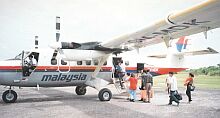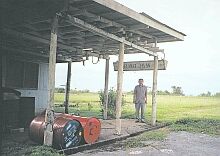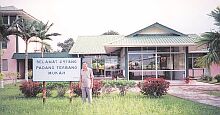| Sunday Star, December 10, 2000
Living No-frills air service at full throttle Story and pictures by Colin Khoo TOUCHDOWN at Mukah. It's just another flight into the hinterlands of Sarawak. After circling off the coast of Mukah, the Twin Otter aligns itself with the stretch of asphalt on the coastal plateau (visible through a break in the clouds) and makes its descent. Below the cumuli, a miniature airport comes into full view. The aircraft's little body, half-filled with passengers, reveberates a notch further as it noses down towards the runway. A few tentative bumps and jerks assure us that we've landed and the aircraft soon screeches to a halt beside the airport. Outside, the coastal breeze, open space and the small rustic airport await the passage of passengers.
Inside the small plane, passengers erupt into a bustle of activity after an hour of inactivity. They're back from Miri, from vacation or trade. In Mukah, as in other small towns and villages in Sarawak, flying is common, and sometimes the only mode of transportation available. The denseness of Sarawak's jungles, and its numerous mountains and rivers, isolate one district from another. Before the air strip was constructed, folks in Mukah travelled solely by boats navigating through the intricate maze of rivers meandering through the jungles; or skirting along the coast (if the destination was a sea-side town). In 1958, a petition was made for a local air-service. Over brandy, cigars and a game of chess, Kapitan Wee Lam Hai brought up the plight of the villagers, and discussed the matter late into the night with the British Governor of Sarawak then, Sir Anthony Abell. Wee says the approval came a few months after that eventful binge, and work soon began on the construction of the runway. In 1959, Mukah saw its first in-country flight; and the very person who made this possible landed on himself the multi-functional task of running the service and handling the flights. "Back then, there were three flights a week to Mukah. I was the only person running the show; working as the air-traffic controller, besides having to take care of the handling and administrative work,'' Wee says. What now lies at the far end of the runway as an abandoned shack, left to the wear and tear of time and sea-salt, is the original building of the airport. A testament of change and a part of this small town's unwritten history, it nevertheless lies untended. Not more than a hundred metres away, the new building with its extensions and control tower bustles a little for about 10 minutes as the passengers move out from this transit point with relatives or friends who have come to greet them.
The bureaucracy and rush of urban airports is not to be seen here. About three times a day, the sound of a lone Twin Otter making its way to the runway is the only break in the quiet solitude of this place. Though there's only a few flights a day (sometimes five, if the need is there), flying remains the most popular form of transportation in Mukah. Kang Hiew Hai, a local businessman who's a frequent flier, says that before the air service was available, folks here used to travel on foot or boats. "We had to trek for miles into the jungle (which had no proper paths) before reaching Sungai Kut where its numerous tributaries would take us to our various destinations. "Of course, there was also the question of tides, which determined the journey for us as there were no motor boats then,'' he relates. Abiding by the erratic schedule of tides and the unquestionable weather, the ride, say, to a nearby town like Miri could sometimes take weeks. It's only an hour away by air. On these river rides, floods could mean indefinite delay; leaving the passengers with little else but to camp out for the nonce before the next lull sets in. Kapitan Wee says the recent boom in the sago palm industry, which has attracted many Thai business people to Mukah, has increased the demand for flights in Mukah. Though there's now a network of roads carved into the jungle, flying remains the most convenient mode of travel between Mukah and other towns in Sarawak like Sibu, Kuching and Miri. "This is due to the hassle of travelling on roads which are damaged but remain unfixed for months, as well as the relatively low price of flight tickets,'' Wee explains.
"For example, a flight to Miri costs only RM55 while a taxi ride, which takes eight hours, would only be cheaper by a few dollars.'' This rural air service has also proved to be more than a mere convenience for the folks in this little town. Wee relates an incident where a man's life was saved by a timely transit made by a MAS pilot after the Kapitan had wired in for help. "The man was in the critical stages of appendicitis and there was no hospital around then. I immediately radioed for help and was fortunate that a plane from Bario was heading our way,'' he says. "Well, the man was sent to a hospital in Miri and was saved.'' The rural air service began about 50 years ago as an obligation to the people in the remote interiors of Sarawak when roads were non existent and river was the main, although unreliable, means of transportation. While most of these areas now have serviceable road links, a sizeable portion of the population still prefer the relative convenience of air travel. Today, their needs are served by the Malaysia Airlines Rural Air Service which operates five Twin Otter aircraft. These planes fly on regular scheduled routes to eight rural airstrips including Mukah, Bario in the highlands and Marudi. The pilots steer daily over rough terrain and dense jungles with the most basic of navigational aids. Flying visually most of the time with the aid of weather reports, pilots often have to steer around and above weather conditions to avoid turbulence. In the Bario highlands, for example, where the little airstrip is flanked by high mountains, and where visibility is frequently compromised by clouds and mists, locating the runway can be quite a problem. MAS fleet manager in Miri, Captain Valentjin Nagtegaal recalls one of his first few flights into the interior of Sarawak--a flight to Bario: It was a cloudy day, and Nagtegaal--new to the seemingly homogenous landscape of rural Sarawak--was steering visually, searching for that little runway on a plateau, otherwise unmarked by any infrastructure. Going by the gaps through the cumuli, the captain circled the location where the airstrip was calculated to be. However, nothing but an endless stretch of green and montane landscape reeled by the windscreen between gaps of uniform blue and clouds.
After a bewildering time circling around trying to locate that hidden strip but to no avail, a villager got into the cockpit and briskly pointed out to the captain an undistinguished spot below, saying that his kampung was down there. "It was hard to believe that he could actually spot his kampung from that distance,'' Nagtegaal relates. "Well, I followed the rough finger-sketches he gave and, sure enough, I found the runway.'' Nowadays, he assures, Twin Otters no longer face such problems as they are equipped with better navigational aids. For the villagers in Bario, the three daily flights to Long Banga, Miri and Marudi represent the only means of getting out of their remote highlands, barring a long and tedious trek, of course. Paulus Thulu, a civil servant in Miri, says that prior to the air service, the only way out of the village was through the jungle--a wild walk through the woods. "In order to get to Marudi, we had to track to Liomata, which takes about a week. From there, we had to take a boat to Marudi, and this would take another month,'' says Paulus who was born, and grew up, in Bario. Paulus says there're still hardly any roads in Bario apart from dirt tracks which can only accommodate bikes. "To get to the airstrip, the villagers have to track for about 45 minutes to the clearing on top the plateau,'' he says. "This narrow strip of dirt has brought about a significant change in the lives of the folks here.'' |



